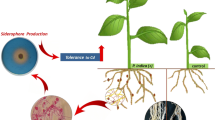Abstract
The effect of inoculation with Pseudomonas brassicacearum Am3, Pseudomonas marginalis Dp1 and Rhodococcus sp. Fp2 containing 1-aminocyclopropane-1-carboxylate deaminase (ACCD) on growth and uptake of N, P, K, Ca, S, Fe and Cd in shoots of pea (Pisum sativum) genotypes VIR188, VIR1658, VIR3429 and VIR4488 was studied in pot experiment with non-polluted and Cd-supplemented (10 mg Cd kg−1) sod-podzolic soil. The growth-promoting effect of bacteria depended on plant genotype and bacterial strain. Only Rhodococcus sp. Fp2 had no ACCD activity in vitro in the presence of Cd and did not stimulate pea growth in Cd-supplemented soil. Inoculation with bacteria counteracted the Cd-induced inhibition of nutrient uptake by plants probably through stimulation of root growth and enhancement of nutrient uptake processes. Nutritional effects of the bacteria were specific with respect to the nutrient.
Similar content being viewed by others
References
Arinushkina EV (1970) Handbook on chemical analysis of soils. Moscow University Press, Moscow (In Russian)
Bashan Y (1990) Short exposure to Azospirillum brasilense Cd inoculation enhanced proton efflux of wheat roots. Can J Microbiol 36:419–425
Belimov AA, Dietz K-J (2000) Effect of associative bacteria on element composition of barley seedlings grown in solution culture at toxic cadmium concentrations. Microbiol Res 155:113–121
Belimov AA, Safronova VI, Sergeyeva TA, Egorova TN, Matveyeva VA, Tsyganov VE, Borisov AY, Tikhonovich IA (2001) Characterisation of plant growth-promoting rhizobacteria isolated from polluted soils and containing 1-aminocyclopropane-1-carboxylate deaminase. Can J Microbiol 47:642–652
Belimov AA, Safronova VI, Mimura T (2002) Response of spring rape to inoculation with plant growth-promoting rhizobacteria containing 1-aminocyclopropane-1-carboxylate deaminase depends on nutrient status of the plant. Can J Microbiol 48:189–199
Belimov AA, Safronova VI, Tsyganov VE, Borisov AY, Kozhemyakov AP, Stepanok VV, Martensson AM, Gianinazzi-Pearson V, Tikhonovich IA (2003) Genetic variability in tolerance to cadmium and accumulation of heavy metals in pea (Pisum sativum L.). Euphytica 131:25–35
Belimov AA, Kunakova AM, Safronova VI, Stepanok VV, Yudkin LY, Alekseev YV, Kozhemyakov AP (2004) Employment of rhizobacteria for the inoculation of barley plants cultivated in soil contaminated with lead and cadmium. Microbiology (Moscow) 73:99–106
Bertrand H, Plassard C, Pinochet X, Touraine B, Normand P, Cleyet-Marel JC (2000) Stimulation of ionic transport system in Brassica napus by a plant growth-promoting rhizobacterium (Achromobacter sp.). Can J Microbiol 46:229–236
Bradford M (1976) A rapid and sensitive method for the quantification of microgram quantities of protein utilizing the principle of protein-dye binding. Anal Biochem 72:248–258
Burd GI, Dixon DG, Glick BR (1998) A plant growth promoting bacterium that decreases nickel toxicity in plant seedlings. Appl Environ Microbiol 64:3663–3668
Burd GI, Dixon DG, Glick BR (2000) Plant growth promoting bacteria that decrease heavy metal toxicity in plants. Can J Microbiol 46:237–245
Dobbelaere S, Vanderleyden J, Okon Y (2003) Plant growth-promoting effects of diazotrophs in the rtizosphere. Crit Rev Plant Sci 22:107–149
Gadd GM (1990) Heavy metal accumulation by bacteria and other microorganisms. Experientia 46:834–840
Glick BR, Penrose DM, Li J (1998) A model for the lowering of plant ethylene concentrations by plant growth-promoting bacteria. J Theor Biol 190:63–68
Hernandez LE, Carpena-Ruiz R, Garate A (1996) Alterations in the mineral nutrition of pea seedlings exposed to cadmium. J Plant Nutr 19:1581–1598
Mantelin S, Touraine B (2004) Plant growth-promoting bacteria and nitrate availability: impacts on root development and nitrate uptake. J Exp Bot 55:27–34
Pennasio S, Roggero P (1992) Effect of cadmium and nickel on ethylene biosynthesis in soybean. Biol Plant 34:345–349
Penrose DM, Glick BR (2001) Levels of 1-aminocyclopropane-1-carboxylic acid (ACC) in exudates and extracts of canola seeds treated with plant growth-promoting bacteria. Can J Microbiol 47:368–372
Pishchik VN, Vorobyev NI, Chernyaeva II, Timofeeva SV, Kozhemyakov AP, Alexeev YV, Lukin SM (2002) Experimental and mathematical simulation of plant growth promoting rhizobacteria and plant interaction under cadmium stress. Plant Soil 243:173–186
Rodriguez H, Fraga R (1999) Phosphate solubilizing bacteria and their role in plant growth promotion. Biotechnol Adv 17:319–339
Saleh SS, Glick BR (2001) Involvement of gacS and rpoS in enhancement of the plant growth-promoting capabilities of Enterobacter cloacae CAL2 and UW4. Can J Microbiol 47:698–705
Sandalio LM, Dalurzo HC, Gomez M, Romero-Puertas MC, del Rio LA (2001) Cadmium-induced changes in the growth and oxidative metabolism of pea plants. J Exp Bot 52:2115–2126
Sanita di Toppi L, Gabrielli R (1999) Response to cadmium in higher plants. Environ Exp Bot 41:105–130
Wuertz S, Mergeay M (1997) The impact of heavy metals on soil microbial communities and their activities. In: Van Elsas JD, Trevors JT, Wellington EMH (eds) Modern soil microbiology. Marcel Dekker, New York, pp 607–642
Acknowledgements
The authors are grateful to Ms. N.L. Yablunina for determination of total N in plants and to Dr. I.C. Dodd for critical reading of this manuscript. This work was supported by the EU-RTD INCO Copernicus (project IC15-CT 98-0116).
Author information
Authors and Affiliations
Corresponding author
Rights and permissions
About this article
Cite this article
Safronova, V.I., Stepanok, V.V., Engqvist, G.L. et al. Root-associated bacteria containing 1-aminocyclopropane-1-carboxylate deaminase improve growth and nutrient uptake by pea genotypes cultivated in cadmium supplemented soil. Biol Fertil Soils 42, 267–272 (2006). https://doi.org/10.1007/s00374-005-0024-y
Received:
Revised:
Accepted:
Published:
Issue Date:
DOI: https://doi.org/10.1007/s00374-005-0024-y




